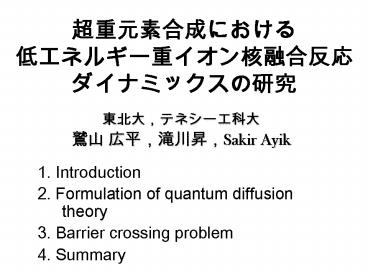,,Sakir Ayik - PowerPoint PPT Presentation
1 / 17
Title: ,,Sakir Ayik
1
???????????????????????????????????
- ???,???????
- ?? ??,???,Sakir Ayik
- 1. Introduction
- 2. Formulation of quantum diffusion theory
- 3. Barrier crossing problem
- 4. Summary
2
2
? Reaction
Formation process
3
3
J formation process
- Conditional saddle is inside the Coulomb barrier.
- Nuclear intrinsic degrees of freedom are excited.
- ? Energy dissipation
- ? Quasi-fission process is dominant.
- Energy dissipation and diffusion process.
4
Classical diffusion process
4
?Classical diffusion theory (C.D.T.)
(b reduced friction coefficient)
Thermal fluctuation is considered.
5
The problems of C.D.T.
5
- The reaction must be occurred
- at low temperature (1 MeV) to get
- the evaporation residues.
- The fission barrier (which arise
- from shell correction energy)
- vanishes at high excitation energies.
- The curvature of
- the conditional saddle (1 MeV).
6
6
Quantum effect is dominant for the case of low
temperature (1 MeV).
We apply quantum diffusion theory to formation
process and calculate the probability to
overcome the conditional saddle.
7
7
- Formulation of QDT
(See nucl-th/0203043, PRC69(2004)054605 for
details.)
- von Neumann eq.
HA collective degrees of freedom to fuse HB
nuclear intrinsic degrees of freedom
(heat bath, environment) VC coupling A with B
Galilei trans.
- Classical trajectory
8
8
- Fluctuation force
- We expand the von Neumann equation with respect
to f (q(t), x).
9
9
- Wigner transformation
c.f. Kramers equation
Classical fluctuation-dissipation theorem
? ?
? Friction coefficient
? Diffusion coefficient
10
10
- Caldeira-Leggett model
?(), ?(-) by Caldeira-Leggett model
?Spectral function
Consistent with the linear response theory.
11
11
?Caldeira-Leggett model
subspace B Environment
?Spectral densityOhmic dissipation
friction coefficient
12
12
?Normalized ?(E)(t) (diffusion coef.)
? Temperature
non-Markovian effect
Horizontal line Temperature
13
13
?1-dim. barrier crossing problem.
Conditional saddle parabola
P
erfc
14
_at_ Note
14
- We assume that DAW(p,q,t) is a Gaussian.
-1
Classical trajectory is given by
W is the barrier curv.(1MeV)
15
15
?Barrier Crossing Probability
Quantum .D.T Classical .D.T const. Q.D.T
neglect the non -Markovian effect
non- Markovian effect
16
Summary
16
- We develop the quantum diffusion theory and apply
it to the dynamical formation process. - The formation probability of QDT is enhanced
compare with that of classical diffusion theory.
17
17
Future works
- Apply to super-Ohmic case.
- Multi-dimensional diffusion.
- Friction force.
- Initial channel energy dissipation
- Fission statistical and dynamical decay mode.






























